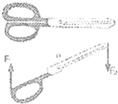问题
问答题
如图所示剪刀的工作原理实际上就是杠杆的一种应用.
(1)请按图中的提示画出动力臂(标示为L1)和阻力臂(标示为L2).
(2)在 ______情况下,使用该剪刀比较省力,即该剪刀是省力杠杆.

答案
(1)过支点O分别作动力作用线和阻力作用的垂线段,即动力臂L1和阻力臂L2.如图所示

(2)因为省力杠杆是指动力臂大于阻力臂的杠杆,因此在动力臂大于阻力臂的情况下,使用剪刀比较省力,并且动力臂与阻力臂的比值越大时,使用起来会更加省力.
故答案为:动力臂大于阻力臂.
